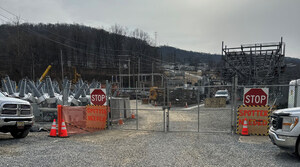AKRON, Ohio, Dec. 14, 2017 /PRNewswire/ -- FirstEnergy Corp. (NYSE: FE) is seeking permits to build the Center for Advanced Energy Technology, an 88,000 square-foot facility in Akron, Ohio, dedicated to evaluating, testing and training staff on new, digital grid technologies that enhance the company's ability to serve customers.
The Center will support FirstEnergy's efforts to modernize the electric grid across its six-state territory. It will provide engineers and other technicians with a hands-on environment for upgrading and maintaining the power grid by simulating real-world conditions on the electric transmission system.
Approximately 20-25 FirstEnergy employees will be assigned to staff the new facility, which will provide classroom space for training up to 50 people on new grid technologies, including digital relay devices that can remotely pinpoint the location of an equipment failure. The facility will also be used for evaluating and testing equipment to ensure that it complies with the latest industry standards, including cybersecurity.
"The Center will directly support FirstEnergy's efforts to design and build a smarter energy infrastructure," said Carl Bridenbaugh, vice president, Transmission. "Across our system, we're replacing older, mechanical devices with new digital devices that can be remotely monitored and can react to real-time issues on the electric grid. Having a facility where we can evaluate and test these technologies under real-world conditions will help us keep power flowing to our customers around the clock."
The facility will cost approximately $37 million and will be located next to FirstEnergy's existing West Akron campus. The company will seek the necessary permits from the city to build the Center and expects to break ground for the facility next spring.
FirstEnergy expects to submit this project to be considered for the U.S. Green Building Council's Leadership in Energy and Environmental Design (LEED) certification. LEED is an internationally recognized third-party green building certification system that recognizes buildings that have met the highest possible green building standards and verifies a project's level of environmental responsibility and ability to provide occupants with a healthy place to live and work.
The Center will support Energizing the Future, a multi-year investment initiative aimed at upgrading FirstEnergy's transmission facilities with advanced equipment and technologies that will reinforce the power grid and help reduce the frequency and duration of customer outages. Since 2014, FirstEnergy has upgraded or replaced existing transmission lines, incorporated new, smart technology into the grid, and outfitted dozens of substations with new equipment and enhanced security features. These upgrades are producing reliability improvements across the company's transmission system.
FirstEnergy is dedicated to safety, reliability and operational excellence. Its 10 electric distribution companies form one of the nation's largest investor-owned electric systems, serving customers in Ohio, Pennsylvania, New Jersey, West Virginia, Maryland and New York. The company's transmission subsidiaries operate more than 24,000 miles of transmission lines that connect the Midwest and Mid-Atlantic regions. Follow FirstEnergy on Twitter @FirstEnergyCorp or online at www.firstenergycorp.com.
Forward-Looking Statements: This news release includes forward-looking statements based on information currently available to management. Such statements are subject to certain risks and uncertainties. These statements include declarations regarding management's intents, beliefs and current expectations. These statements typically contain, but are not limited to, the terms "anticipate," "potential," "expect," "forecast," "target," "will," "intend," "believe," "project," "estimate," "plan" and similar words. Forward-looking statements involve estimates, assumptions, known and unknown risks, uncertainties and other factors that may cause actual results, performance or achievements to be materially different from any future results, performance or achievements expressed or implied by such forward-looking statements, which may include the following: the ability to experience growth in the Regulated Distribution and Regulated Transmission segments and the effectiveness of our strategy to transition to a fully regulated business profile; the accomplishment of our regulatory and operational goals in connection with our transmission and distribution investment plans, including, but not limited to, our planned transition to forward-looking formula rates; changes in assumptions regarding economic conditions within our territories, assessment of the reliability of our transmission system, or the availability of capital or other resources supporting identified transmission investment opportunities; the ability to accomplish or realize anticipated benefits from strategic and financial goals, including, but not limited to, the ability to continue to reduce costs and to successfully execute our financial plans designed to improve our credit metrics and strengthen our balance sheet; success of legislative and regulatory solutions for generation assets that recognize their environmental or energy security benefits, including the Notice of Proposed Rulemaking released by the Secretary of Energy and action by the Federal Energy Regulatory Commission (FERC); the risks and uncertainties associated with the lack of viable alternative strategies regarding the Competitive Energy Services (CES) segment, thereby causing FirstEnergy Solutions Corp. (FES), and likely FirstEnergy Nuclear Operating Company (FENOC), to restructure its substantial debt and other financial obligations with its creditors or seek protection under United States bankruptcy laws and the losses, liabilities and claims arising from such bankruptcy proceeding, including any obligations at FirstEnergy Corp.; the risks and uncertainties at the CES segment, including FES, and its subsidiaries, and FENOC, related to wholesale energy and capacity markets and the viability and/or success of strategic business alternatives, such as pending and potential CES generating unit asset sales, the potential conversion of the remaining generation fleet from competitive operations to a regulated or regulated-like construct or the potential need to deactivate additional generating units, which could result in further substantial write-downs and impairments of assets; the substantial uncertainty as to FES' ability to continue as a going concern and substantial risk that it may be necessary for FES, and likely FENOC, to seek protection under United States bankruptcy laws; the risks and uncertainties associated with litigation, arbitration, mediation and like proceedings, including, but not limited to, any such proceedings related to vendor commitments, such as long-term fuel and transportation agreements; the uncertainties associated with the deactivation of older regulated and competitive units, including the impact on vendor commitments, such as long-term fuel and transportation agreements, and as it relates to the reliability of the transmission grid, the timing thereof; the impact of other future changes to the operational status or availability of our generating units and any capacity performance charges associated with unit unavailability; changing energy, capacity and commodity market prices including, but not limited to, coal, natural gas and oil prices, and their availability and impact on margins; costs being higher than anticipated and the success of our policies to control costs and to mitigate low energy, capacity and market prices; replacement power costs being higher than anticipated or not fully hedged; our ability to improve electric commodity margins and the impact of, among other factors, the increased cost of fuel and fuel transportation on such margins; the uncertainty of the timing and amounts of the capital expenditures that may arise in connection with any litigation, including New Source Review litigation, or potential regulatory initiatives or rulemakings (including that such initiatives or rulemakings could result in our decision to deactivate or idle certain generating units); changes in customers' demand for power, including, but not limited to, changes resulting from the implementation of state and federal energy efficiency and peak demand reduction mandates; economic or weather conditions affecting future sales, margins and operations such as a polar vortex or other significant weather events, and all associated regulatory events or actions; changes in national and regional economic conditions affecting us, our subsidiaries and/or our major industrial and commercial customers, and other counterparties with which we do business, including fuel suppliers; the impact of labor disruptions by our unionized workforce; the risks associated with cyber-attacks and other disruptions to our information technology system that may compromise our generation, transmission and/or distribution services and data security breaches of sensitive data, intellectual property and proprietary or personally identifiable information regarding our business, employees, shareholders, customers, suppliers, business partners and other individuals in our data centers and on our networks; the impact of the regulatory process and resulting outcomes on the matters at the federal level and in the various states in which we do business including, but not limited to, matters related to rates; the impact of the federal regulatory process on FERC-regulated entities and transactions, in particular FERC regulation of wholesale energy and capacity markets, including PJM Interconnection, L.L.C. (PJM) markets and FERC-jurisdictional wholesale transactions; FERC regulation of cost-of-service rates; and FERC's compliance and enforcement activity, including compliance and enforcement activity related to North American Electric Reliability Corporation's mandatory reliability standards; the uncertainties of various cost recovery and cost allocation issues resulting from American Transmission Systems, Incorporated's realignment into PJM; the ability to comply with applicable state and federal reliability standards and energy efficiency and peak demand reduction mandates; other legislative and regulatory changes, including the new federal administration's required review and potential revision of environmental requirements, including, but not limited to, the effects of the United States Environmental Protection Agency's Clean Power Plan, Coal Combustion Residuals regulations, Cross-State Air Pollution Rule and Mercury and Air Toxics Standards programs, including our estimated costs of compliance, Clean Water Act (CWA) waste water effluent limitations for power plants, and CWA 316(b) water intake regulation; adverse regulatory or legal decisions and outcomes with respect to our nuclear operations (including, but not limited to, the revocation or non-renewal of necessary licenses, approvals or operating permits by the Nuclear Regulatory Commission or as a result of the incident at Japan's Fukushima Daiichi Nuclear Plant); issues arising from the indications of cracking in the shield building at Davis-Besse; changing market conditions that could affect the measurement of certain liabilities and the value of assets held in our Nuclear Decommissioning Trusts, pension trusts and other trust funds, and cause us and/or our subsidiaries to make additional contributions sooner, or in amounts that are larger than currently anticipated; the impact of changes to significant accounting policies; the impact of any changes in tax laws or regulations or adverse tax audit results or rulings; the ability to access the public securities and other capital and credit markets in accordance with our financial plans, the cost of such capital and overall condition of the capital and credit markets affecting us and our subsidiaries; further actions that may be taken by credit rating agencies that could negatively affect us and/or our subsidiaries' access to financing, increase the costs thereof, increase requirements to post additional collateral to support, or accelerate payments under outstanding commodity positions, letters of credit and other financial guarantees, and the impact of these events on the financial condition and liquidity of FirstEnergy Corp. and/or its subsidiaries, specifically FES and its subsidiaries; issues concerning the stability of domestic and foreign financial institutions and counterparties with which we do business; and the risks and other factors discussed from time to time in our United States Securities and Exchange Commission (SEC) filings, and other similar factors. A security rating is not a recommendation to buy or hold securities and is subject to revision or withdrawal at any time by the assigning rating agency. Each rating should be evaluated independently of any other rating. These forward-looking statements are also qualified by, and should be read in conjunction with the other cautionary statements and risks that are included in our filings with the SEC, including but not limited to the most recent Annual Report on Form 10-K and any subsequent Quarterly Reports on Form 10-Q. The foregoing review of factors also should not be construed as exhaustive. New factors emerge from time to time, and it is not possible for management to predict all such factors, nor assess the impact of any such factor on our business or the extent to which any factor, or combination of factors, may cause results to differ materially from those contained in any forward-looking statements. We expressly disclaim any current intention to update, except as required by law, any forward-looking statements contained herein as a result of new information, future events or otherwise.
SOURCE FirstEnergy Corp.
Related Links
WANT YOUR COMPANY'S NEWS FEATURED ON PRNEWSWIRE.COM?
Newsrooms &
Influencers
Digital Media
Outlets
Journalists
Opted In






Share this article